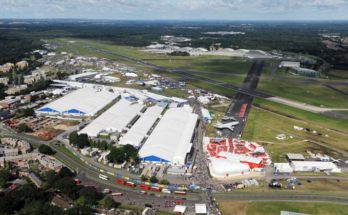
Bombardier‘s ongoing recovery is picking up pace as years of restructuring and turmoil are beginning to pay off.
As part of its long-term strategy, the company has refocused itself as a pure-play aerospace company focused on large-cabin business jets. The company shed numerous operations in both the aerospace and transportation sector. The most recent deal was the sale of its rail operations to Alstom in 2021.
Prior to this, Bombardier completed four major sales in the aerospace sector – the CSeries to Airbus, the Q400 to Longview Aircraft, the CRJ to Mitsubishi Heavy Industries (MHI), and its Belfast aerostructures operations to Spirit AeroSystems.
These moves have transformed Bombardier into a company with a nearly singular focus on the manufacture and support of bizjets. This sector weathered the pandemic better than most of the aerospace industry, as travelers chose to fly private amid safety and health concerns. Even as commercial air travel resumed, the snarls and delays at many air carriers pushed many first-class passengers to fly private, continuing a trend that started with the pandemic. This has led to roaring demand for business jets.
Halfway through 2023, Bombardier reported that backlog is holding steady at $14.9 billion, up 1 percent from $14.8 billion at year-end 2022. The more interesting data point is that aftermarket revenue rose 18 percent to $852 million in the first half. Aftermarket is a sector that the company has been investing in heavily in the past few years, with numerous expansions around the world growing the company’s support network. New and expanded operations have opened in the UAE, U.K., USA, Australia, Europe, and Singapore, expanding its aftermarket footprint by almost 1 million square feet. Overall, this strategy appears to be working, as Bombardier’s aftermarket revenues have grown by more than 50 percent since 2020, hitting around $1.5 billion in 2022, and it is on track to meet its goal of $2 billion by 2025.
Thanks to strong market demand, the company is pushing up its delivery target for 2023 to 138 aircraft, compared to 123 in 2022. Longer-term, Bombardier is forecasting to deliver more than 150 jets by 2025. The company has said that it believes this target is achievable but warns that supply chain issues could reemerge as a pain point. To help alleviate supply chain problems, Bombardier decided to buy back its wiring business in Queretaro, Mexico, from Latécoère, which it originally sold for $50 million in 2019. The re-addition of this operation reinforces the company’s supply chain, allowing Bombardier to bring electrical harness manufacturing in-house. Acquisitions such as these may continue in the years ahead as the company increases its vertical integration in order to gain more control over component production.
Buoyed by strong markets and the success of its aftermarket initiative, Bombardier has raised its short-term revenue targets and now is aiming for $9 billion in revenue by 2025. Previously, the company was targeting $7.5 billion. The company is moving in the right direction, having posted net sales of $6.9 billion in 2022, up 13.6 percent from sales of $6.1 billion in 2021.
With the storied Learjet now out of production, Bombardier has repurposed its Wichita operations. The site not only serves as the company’s U.S. headquarters and as a major service hub, but it is also a focal point for the new Bombardier Defense. This unit, formerly the Specialized Aircraft division, seeks to increase the company’s participation in defense-related programs. The company is producing aircraft for the USAF’s Battlefield Airborne Communications Node (BACN) program and the European Pegasus surveillance system, and modifies aircraft for Saab’s GlobalEye AWAC platform. The company hopes to capitalize not only on defense-related production, but also the long-term support that goes with providing these platforms. Bombardier is looking for this segment to account for about $1 billion in the latter part of the decade.
Bombardier’s management team has taken tough medicine in deconstructing its commercial aerospace operations. With Bombardier’s difficulties behind it and a clear strategy to guide it, its outlook remains bright.
Forecast International’s Defense & Aerospace Companies series consists of two volumes. Volume One includes coverage of over 100 key U.S. and Canadian primes and their subsidiaries. Volume Two covers over 90 top companies and subsidiaries outside North America, with a focus on key players in Europe and Asia. The services’ reports contain detailed data on recent programs, mergers, competitions, and joint ventures, along with financial data and contract awards. Click here to learn more.
A military history enthusiast, Richard began at Forecast International as editor of the World Weapons Weekly newsletter. As the Internet grew in importance as a research tool, he helped design the company's Forecast Intelligence Center and currently coordinates the EMarket Alert newsletters for clients. Richard also manages social media efforts, including two new blogs: Defense & Security Monitor, covering defense systems and international issues, and Flight Plan, which focuses on commercial aviation and space systems. For over 30 years, Richard has authored the Defense & Aerospace Companies, Volume I (North America) and Volume II (International) services. The two books provide detailed data on major aerospace and defense contractors. He also edits the International Contractors service, a database that tracks all the contractors involved in the programs covered in the FI library. More recently he was appointed Manager, Information Services Group (ISG), a new unit that encompasses developing outbound content for both Forecast International and Military Periscope.



